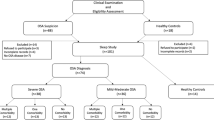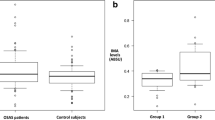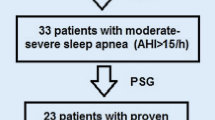Abstract
The aim of this study was to establish cardiac damage related to nocturnal ischemia using heart type fatty acid binding protein (h-fabp), which reaches detectable levels in plasma after being released from myocytes in case of ischemia in obstructive sleep apnea syndrome (OSAS) patients without coronary artery disease (CAD). Fifty patients diagnosed with OSAS in our sleep laboratory with polysomnographic analysis (PSG), who did not have any previous history of cardiac disease and in whom CAD was ruled out with myocardium perfusion scintigraphy, were included in the study. Control group comprised 19 volunteers without history of cardiac disease and risk factors in whom OSAS was excluded with PSG analysis. Blood samples were drawn from the patients to examine h-fabp, creatine kinase (CK), creatine kinase-MB (CK-MB), aspartate aminotransferase (AST), troponin I levels before and after sleep. No significant difference was found in CK, CK-MB, AST, Troponin I, and h-fabp levels before and after sleep in patient and control groups (p > 0.05). No significant difference was found between groups in terms of CK, CK-MB, AST, and Troponin I levels before and after sleep, while a significant difference was found between them with regard to h-fabp levels before (p = 0.006) and after sleep (p = 0.022). When arithmetical mean of the fabp levels before and after sleep was taken in the patient group, it was found that mean value of h-fabp was associated with the desaturated period in sleep which was under 80% (p = 0.04). H-fabp seems to be a marker that will enable the detection of cardiac injury in the early asymptomatic period in OSAS patients before development of disease that can be detected by imaging methods. Further studies are required to investigate the relation between the value of h-fabp and the development of cardiac dysfunction in the long term.
Similar content being viewed by others
References
Young T, Palta M, Dempsey J et al (1993) The occurrence of sleep-disordered breathing among middle-aged adults. N Engl J Med 328(17):1230–1235
Lattimore J-DL, Celermajer DS, Wilcox I (2003) Obstructive sleep apnea and cardiovascular disease. J Am Coll Health 41:1429–1437
McNicholas WT, Bonsignore MR (2007) Sleep apnoea as an independent risk factor for cardiovascular disease: current evidence, basic mechanisms and research priorities. Eur Respir J 29(1):156–178 (Jan)
Marin JM, Carrizo SJ et al (2005) Long-term cardiovascular outcomes in men with obstructive sleep apnoea–hypopnoea with or without treatment with continuous positive airway pressure: an observational study. Lancet 365(9464):1046–1053 (Mar 19–25)
Parish JM, Somers VK (2004) Obstructive sleep apnea and cardiovascular disease. Mayo Clin Proc 79(8):1036–1046 (August)
Andreas S, Schultz R, Werner GS, Kreuzer H (1996) Prevalence of obstructive sleep apnea in patients with coronary artery disease. Coron Artery Dis 7:541–545
Peled N, Abinader EG, Pillar G, Sharif D, Lavie P (1999) Nocturnal ischemic events in patients with obstructive sleep apnea syndrome and ischemic heart disease: effects of continuous positive air pressure treatment. J Am Coll Cardiol 34(6):1744–1749 (Nov 15)
Hanly P, Sasson Z et al (1993) ST-segment depression during sleep in obstructive sleep apnea. Am J Cardiol 71(15):1341–1345
Alhadi HA, Fox KA (2004) Do we need additional markers of myocyte necrosis: the potential value of heart fatty acid binding protein. Q J Med 97:187–198
Nakata T et al (2003) Human Heart type fatty acid binding protein as an early diagnostic and prognostic marker in acute coronary syndrome. Cardiology 99:96–104
Schafer H, Koehier U, Ploch T et al (1997) Sleep related myocardial ischemia and sleep structure in patients with obstructive sleep apnea and coronary heart disease. Chest 111:387–393
Alonso-Fernández A, García-Río F et al (2005) Cardiac rhythm disturbances and ST-segment depression episodes in patients with obstructive sleep apnea–hypopnea syndrome and its mechanisms. Chest 127:15–22
Andreas S, Hajak G, Natt P et al (1991) ST segmental changes and arrhythmias in obstructive sleep apnea. Pneumologie 45(9):720–724
Hanly P, Sasson Z, Zuberi N et al (1993) ST-segment depression during sleep in obstructive sleep apnea. Am J Cardiol 71:1341–1345
Franklin KA, Nilsson JB, Sahlin C et al (1995) Sleep apnoea and nocturnal angina. Lancet 345:1085–1087
Gami AS, Svatikova A, Wolk R et al (2004) Cardiac troponin T in obstructive sleep apnea. Chest 125(6):2097–2100
Pepin JL, Levy P (2002) Pathophysiology of cardiovascular risk in sleep apnea syndrome (SAS). Rev Neurol (Paris) 158(8–9):785–797
Narkiewicz K, Somers VK (2003) Sympathetic nerve activity in obstructive sleep apnea. Acta Physiol Scand 177:385–390
Somers VK, Dyken ME, Clary MP, Abboud FM (1995) Sympathetic neural mechanisms in obstructive sleep apnea. J Clin Invest 96:1897–904
Aydin M, Altin R (2004) Cardiac autonomic activity in obstructive sleep apnea. Tex Heart Inst J 31(2):132–136
Noda A, Ito R, Okada T et al (1998) Twenty-four-hour ambulatory oxygen desaturation and electrocardiographic recording in obstructive sleep apnea syndrome. Clin Cardiol 21(7):506–510 (Jul)
Yoshimoto K, Tanaka T, Somiya K et al (1995) Human heart-type cytoplasmic fatty acid-binding protein as an indicator of acute myocardial infarction. Heart Vessels 10:304–309
Zschiesche W, Kleine AH, Spitzer E, Veerkamp JH, Glatz JF (1995) Histochemical localization of heart-type fatty acid-binding protein in human and murine tissues. Histochem Cell Biol 103:147–156
Azzazy HME, Pelsers MMAL, Christenson RH (2006) Unbound free fatty acids and heart-type fatty acid-binding protein: diagnostic assays and clinical applications. Clin Chem 52:19–29
Gorski J, Hermens WT, Borawski J, Mysliwiec M, Glatz JF (1997) Increased fatty acid-binding protein concentration in plasma of patients with chronic renal failure. Clin Chem 43:193–195
Tanaka T, Hirota Y, Sohmiya K, Nishimura S, Kawamura K (1991) Serum and urinary human heart fatty acid-binding protein in acute myocardial infarction. Clin Biochem 24:195–201
Wodzig KW, Pelsers MM, Van der Vusse GJ, Roos W, Glatz JF (1997) One-step enzyme-linked immunosorbent assay (ELISA) for plasma fatty acid-binding protein. Ann Clin Biochem 34:263–268
Tsuji R, Tanaka T, Sohmiya K et al (1993) Human heart-type cytoplasmic fatty acid-binding protein in serum and urine during hyperacute myocardial infarction. Int J Cardiol 41:209–217
Kleine AH, Glatz JF, Van Nieuwenhoven FA, Van der Vusse GJ (1992) Release of heart fatty acid-binding protein into plasma after acute myocardial infarction in man. Mol Cell Biochem 116:155–162
Ohkura Y, Asamaya K, Ishii H et al (1995) Development of sandwich enzyme-linked immunosorbent assay fort he determination of human heart type fatty acid-binding protein in plazma and urine by using two different monoclonal antibodies specific for human heart fatty acid binding protein. J Immunol Methods 178:99–111
Author information
Authors and Affiliations
Corresponding author
Rights and permissions
About this article
Cite this article
Oktay, B., Akbal, E., Firat, H. et al. Evaluation of the relationship between heart type fatty acid binding protein levels and the risk of cardiac damage in patients with obstructive sleep apnea syndrome. Sleep Breath 12, 223–228 (2008). https://doi.org/10.1007/s11325-007-0167-1
Received:
Revised:
Accepted:
Published:
Issue Date:
DOI: https://doi.org/10.1007/s11325-007-0167-1




